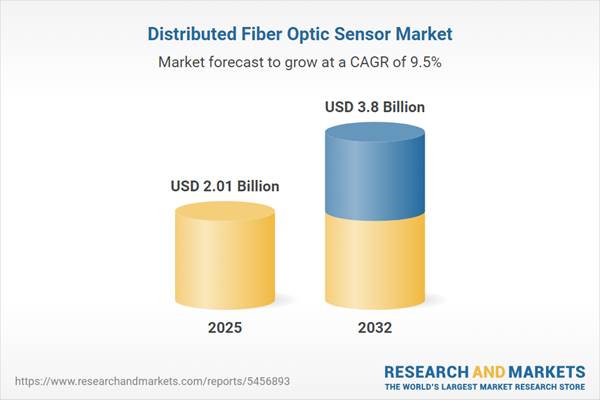Speak directly to the analyst to clarify any post sales queries you may have.
The distributed fiber optic sensor market is transforming infrastructure management across industries, providing real-time insights and supporting operational efficiency for organizations that require precision monitoring and risk reduction.
Market Snapshot: Distributed Fiber Optic Sensor Market Growth and Outlook
The Distributed Fiber Optic Sensor Market expanded from USD 1.83 billion in 2024 to USD 2.01 billion in 2025 and is forecast to reach USD 3.80 billion by 2032, growing at a CAGR of 9.51%.
The market’s growth trajectory reflects increasing demand for continuous, real-time infrastructure monitoring, advanced safety, and digital transformation initiatives across sectors such as energy, transportation, and industrial operations. Continuous innovation in sensor technologies, analytics platforms, and cable design, combined with greater regulatory scrutiny and supply chain adaptations, are setting the stage for further adoption across both developed and emerging markets.Scope & Segmentation: Technology, Application, and Regional Reach
- Applications: Oil & Gas (including offshore and onshore), Power Transmission, Structural Health Monitoring, and Transportation.
- Technologies: Brillouin Scattering (BOTDA, BOTDR), Optical Time Domain Reflectometry, Raman Scattering, Rayleigh Scattering.
- Components: Interrogator Unit, Sensor Cable (Coated, Uncoated), Software & Services.
- End Users: Commercial, Industrial (Energy & Utilities, Manufacturing), Public Infrastructure.
- Fiber Types: Multi Mode, Single Mode (Bend Insensitive, Standard).
- Geographies: Americas, Europe, Middle East, Africa, Asia-Pacific, with coverage down to key countries including the United States, Canada, China, India, Germany, and Australia.
- Companies Profiled: Halliburton Company, Yokogawa Electric Corporation, Fujikura Ltd., Luna Innovations, AP Sensing GmbH, Silixa Ltd., OptaSense Limited, General Electric Company, Weatherford, DarkPulse Inc.
Key Takeaways for Senior Decision-Makers
- Distributed fiber optic sensing technology enables continuous, high-precision monitoring for long infrastructure assets by capturing temperature, strain, and acoustic data in real time.
- Adoption is fueled by the need for predictive maintenance, improved safety, and compliance with increasingly rigorous regulatory standards across energy, utility, transportation, and industrial sectors.
- Strategic investments in modular sensors, advanced analytics, and digital integration are aligning fiber optic sensing with broader digitization and sustainability agendas.
- Deployment complexity is mitigated by innovations such as non-invasive retrofits and rapid installation techniques suited for both new and legacy assets.
- Regional market opportunities vary, with established infrastructures driving uptake in North America and Europe, while rapid urbanization and infrastructure expansion accelerate adoption in Asia-Pacific and parts of Latin America.
- Leading vendors are leveraging targeted partnerships to streamline supply chains and enhance their solution portfolios, positioning themselves to address evolving global infrastructure challenges.
Tariff Impact: Navigating Trade Policy and Supply Chain Strategy
Newly implemented U.S. tariffs on fiber optic sensing components are driving industry players to re-examine procurement and production strategies. Companies are shifting toward localized manufacturing and exploring partnerships in markets not subject to these duties. These changes reshape supply chains, force component sourcing innovation, and have prompted increased research on alternative materials and refined product architectures. Smaller suppliers in particular are reassessing pricing models and seeking collaborative approaches to maintain competitiveness in the evolving environment.
Methodology & Data Sources
This report integrates primary interviews with executives, technology experts, and end users, alongside quantitative surveys and an extensive review of industry publications, company filings, and event observations. Data integrity is ensured through cross-validation, triangulation, and expert panel reviews, providing a robust foundation for all trends and forecasts.
Why This Report Matters for Stakeholders in the Distributed Fiber Optic Sensor Market
- Offers actionable insights for supply chain resilience, technological innovation, and regulatory compliance planning.
- Enables strategic prioritization by mapping opportunity hotspots, application-specific challenges, and shifting regional dynamics.
- Supports competitive benchmarking by profiling industry leaders, innovation roadmaps, and partnership strategies across segments.
Conclusion
As organizations adapt to evolving operational, regulatory, and environmental landscapes, distributed fiber optic sensing solutions provide a flexible foundation for real-time asset management. Businesses that strategically invest in modular platforms and collaborative supply chains will be positioned to unlock new levels of infrastructure intelligence and resilience.
Additional Product Information:
- Purchase of this report includes 1 year online access with quarterly updates.
- This report can be updated on request. Please contact our Customer Experience team using the Ask a Question widget on our website.
Table of Contents
3. Executive Summary
4. Market Overview
7. Cumulative Impact of Artificial Intelligence 2025
Companies Mentioned
The companies profiled in this Distributed Fiber Optic Sensor market report include:- Halliburton Company
- Yokogawa Electric Corporation
- Fujikura Ltd.
- Luna Innovations, Inc.
- AP Sensing GmbH
- Silixa Ltd.
- OptaSense Limited
- General Electric Company
- Weatherford
- DarkPulse Inc.
Table Information
| Report Attribute | Details |
|---|---|
| No. of Pages | 198 |
| Published | October 2025 |
| Forecast Period | 2025 - 2032 |
| Estimated Market Value ( USD | $ 2.01 Billion |
| Forecasted Market Value ( USD | $ 3.8 Billion |
| Compound Annual Growth Rate | 9.5% |
| Regions Covered | Global |
| No. of Companies Mentioned | 11 |









